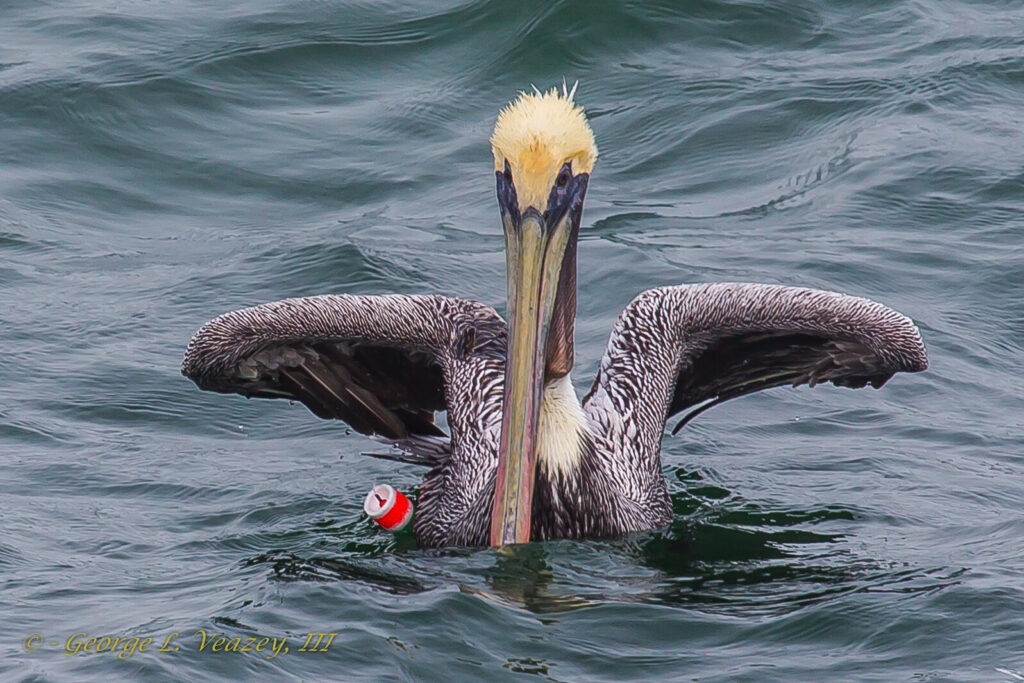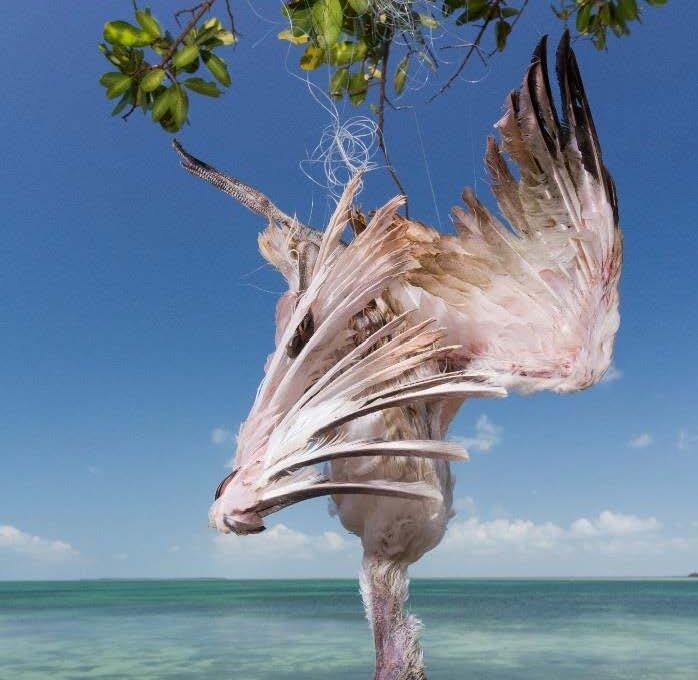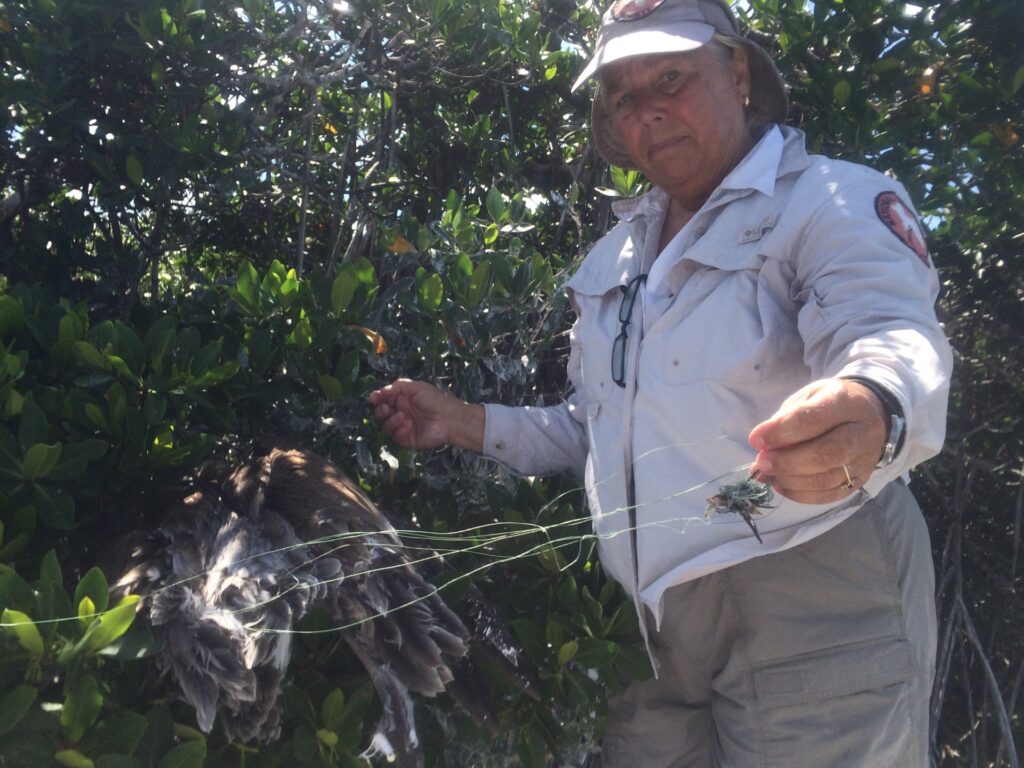
Carnage has become commonplace in Florida – using the word in this context is not an exaggeration. And while none of it happens intentionally, we see it every day, everywhere fishermen and birds, especially brown pelicans, cross “paths” on the water – and the birds get accidentally caught in line, by hooks and fishing gear.
By Ann Paul
It’s not a new problem. Ralph Schreiber, a biologist working in Tampa Bay in the 1970s and ‘80s, repeatedly warned that entanglement in fishing gear was the main cause of mortality for brown pelicans in Florida. In 2013, after the Florida Fish and Wildlife Conservation Commission’s (FWC) down-listed pelicans as a “Species of Special Concern,” its Species Action Plan for the Brown Pelican, reported fishing gear entanglement as a significant problem for pelicans and promised to address the problem.
Also in 2013, Tampa Audubon volunteers led by then-Board Member Sandy Reed and other rescuers began actively capturing and removing fishing hooks, line, and other gear at the Skyway Fishing Pier State Park from ensnared pelicans and other birds. Thousands were taken to rehabilitation centers for advanced care, where approximately half died, too injured to recover.
This rescue effort and continued pressure from the local Audubon chapters and others caught the attention of the wildlife commission, state park managers and the concessionaire at the Skyway Pier. A study by Eckerd College’s Dr. Elizabeth Forys and her students identified the Skyway Pier as the site where more birds are snared by fishing gear than the other regional piers. The commission has convened stakeholder discussions under the umbrella of the Hooked Pelican Working Group, including conservation-minded people, fishermen, agency staff, biologists and others to collaboratively find solutions.
Last week, the FWC board implemented new measures to reduce the number of pelicans caught accidentally by fishermen at the Skyway Pier. Depending on whether you’re a fisherman or an advocate for the birds, the measures are either too much or not nearly enough. Commission Chair Rodney Barreto suggested that the rule-making might have hit the right note, as no one was happy with the results.
The rules approved by the commission should help reduce the likelihood and severity of fishing-gear entanglement at the Skyway Pier. They establish an education requirement for anglers on the Skyway, prohibit the use of fishing rigs with more than one hook from November 15 to March 15, and limit anglers to no more than two sets of hook-and-line gear at a time. Staff are also directed to monitor the effectiveness of these rules, and return with a preliminary report next summer. The commission will review these rules in two years to determine whether they should be repealed or expanded.
As president of the Tampa Audubon Society, I am one of those who is not “happy” with the rules approved by the commissioners but gladdened that they acted at all to protect pelicans and other seabirds from accidentally becoming ensnared by fishermen at the Skyway. In my view, the restriction of multi-hook gear is a very important step. Multi-hook lures and other gear cause significant damage to the bird, hooking it in several places, sometimes attaching beaks or wings to the bodies, making flight impossible. These hooks also make disentangling the birds a challenge, discouraging release of the birds by the fisherman who caught it, and making it more likely that the fisherman will just cut the line, dooming the bird to death.
But the multi-hook restriction covering only the winter months won’t protect the young pelicans and terns — newly fledged, independent and hungry — from entanglement between August when they first leave their nests and the protection of their parents through their first year of life. It won’t protect nesting adults with new eggs laid in February and March, their chicks hatching in April and May, through their growth to become independent young-of-the-year in mid-summer. Since it takes both parents to raise their young – if one of the pair is snared by line and killed or injured, the chicks will die from starvation. The multi-hook restriction needs to be year-round.
Educating fishermen has been a high priority, with signs, brochures and even videos produced by both the FWC and the Audubon chapters and other groups. But the Skyway Pier has 200,000 customers a year, and teaching all of them how to avoid accidentally catching a bird and how to safely release it is difficult. The extra measures that FWC has recommended should help.
Restricting the use of many rods to only two at a time should make a significant difference. It will focus the fishermen’s attention on the two rods, instead of fishing with as many as a dozen rods, as has been the case sometimes on the pier. The education program and rod restriction will start immediately and are not seasonal conditions.
I expect the Hooked Pelican Working Group will meet again and continue to find additional management solutions that can be instituted by the Skyway Pier concessioner and the state park staff.

I also point out that although the Skyway has been identified as the pier with the most pelican entanglements, pelicans and other birds and wildlife are also being caught in large numbers at other piers, by fishermen on boats, from shorelines, and essentially anywhere fishermen and birds co-exist. Therefore, educating fishermen about the best measures to avoid accidentally ensnaring birds and how to safely release them when caught should be a statewide initiative, not something limited to a single site.
Additionally, fishermen should never feed birds, as that teaches them to come to people – thus entering an area where fishing is happening and entanglement is a hazard. It’s already against the law because feeding wild animals is never a good idea, as we know from alligators, bears, sandhill cranes and other wildlife.
For seabirds, it is especially dangerous to be fed the filleted bones and carcasses of big fish. Pelicans and other seabirds as gulls and terns have evolved over thousands of years to swallow small fish whole. Their stomachs dissolve the small fish, allowing them to safely digest the bones. In contrast, when pelicans swallow the bones of large, filleted fish carcasses, as is often the case where fishermen are cleaning their catch at the end of the day, these bones can pierce pouches, gullets, stomachs, and intestines, causing painful peritonitis and eventual death.
Fishermen must learn how to avoid catching a bird by accident, how to release it without getting hurt or causing further injury to the bird, to never feed the birds, even with extra bait and especially the filleted bones of large fish, and to properly dispose of fishing gear and tangled or used line. Yes, it will require that fishermen change their customs and behaviors. But these measures are needed to allow populations of pelicans and other birds to be part of Florida’s future. I ask fishermen, managers of piers and fishing sites everywhere, agency staff, and leaders in the maritime industry to help protect our pelicans and other birds and wildlife.
We can contain the carnage, but it needs to be a concerted, long-term effort with support from both fishermen and bird advocates.
Ann Paul is president of Tampa Audubon, the Florida Ornithological Society and the Florida Birding & Nature Festival. Before retiring, she was Audubon Florida’s regional coordinator for Tampa Bay. Views expressed in this article are the opinion of the writer, not necessarily those of the Tampa Bay Regional Planning Council.


